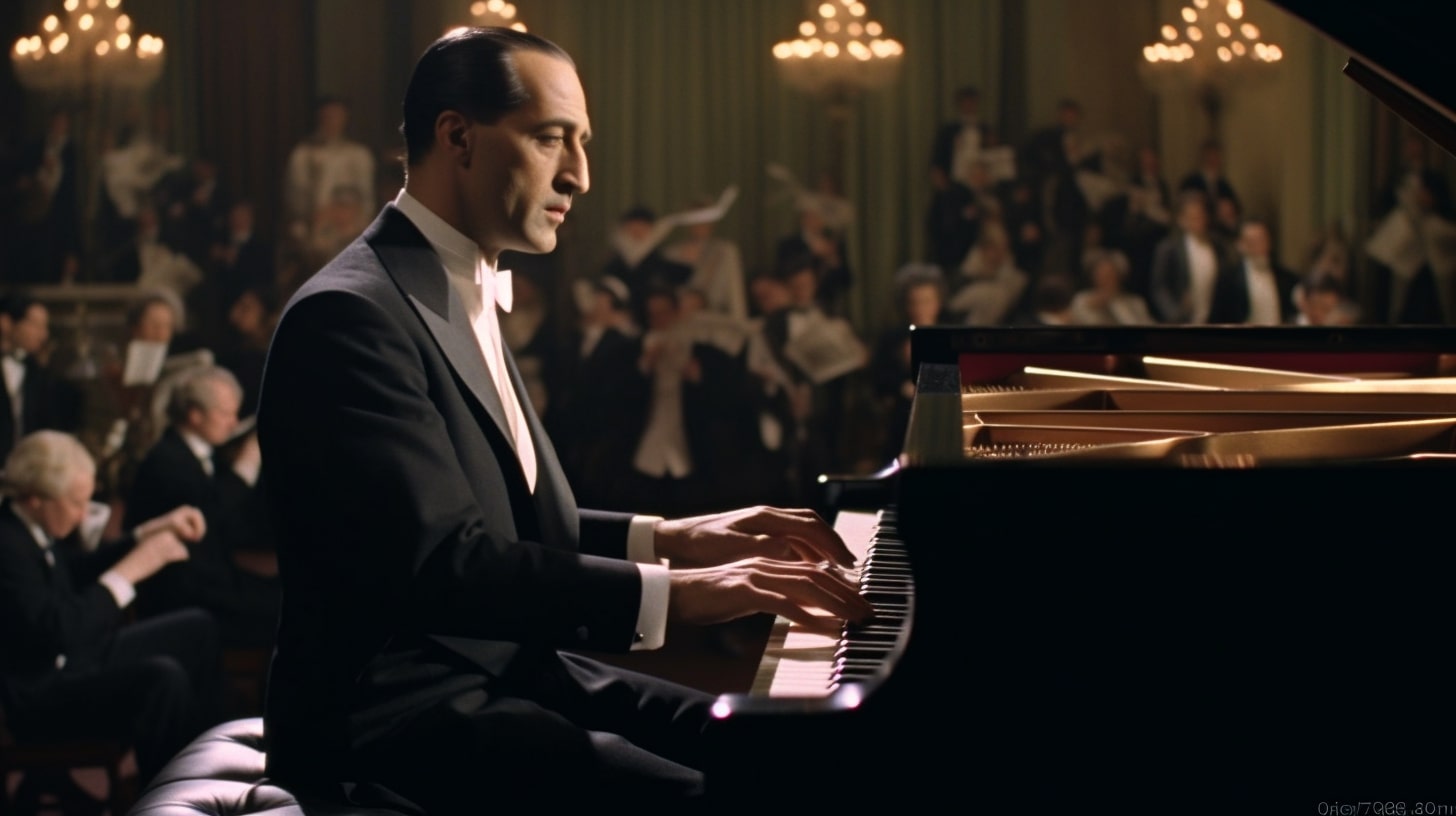George Gershwin was an American composer known for his compositions that spanned popular jazz and classical genres.
Skilled in both classical and popular music styles, Gershwin’s talent allowed him to create works that seamlessly integrated the two genres, earning him a lasting reputation as a significant figure in American music.
To appreciate Greshwin’s true talent, let’s delve into the instruments that he played.
Contents
George Gershwin and the Piano
Early Life and Training
George Gershwin was an American composer and pianist who gained prominence in the early 20th century due to his extraordinary talent for fusing classical music and jazz. Gershwin was born in New York City into a Russian-Jewish immigrant family. As a child, he showed an interest in music and started playing the piano at the age of 10 after his parents bought a second-hand upright piano for his older brother Ira.
Gershwin’s talent became apparent once he started playing the piano. He dropped out of school and began playing piano professionally at age 15. Within a few years of rigorous practice and hard work, Gershwin started composing Broadway theater works, eventually earning him critical acclaim.
Relationship with Charles Hambitzer
One of the key figures in George Gershwin’s life as a pianist and composer was Charles Hambitzer, a pianist and composer himself. Gershwin studied piano under Hambitzer, who recognized the young musician’s potential and took him under his wing. Their relationship was a crucial element in developing Gershwin’s skills and his future success.
In addition to that, Gershwin also studied composition with other noteworthy musicians like Rubin Goldmark, Henry Cowell, and Joseph Brody. With the guidance and support of these experienced mentors, George Gershwin was able to hone his extraordinary talent and leave an indelible mark on American music with compositions like “Rhapsody in Blue.”
The piano was the instrument that George Gershwin mastered and used to significantly impact the musical landscape of the time. His talent, coupled with the guidance from experts like Charles Hambitzer, allowed Gershwin to create timeless pieces of music that continue to be celebrated today.
Key Compositions and Piano Works
Rhapsody in Blue
Rhapsody in Blue, a 1924 musical composition, is one of George Gershwin’s most famous works. Written for solo piano and jazz band, it seamlessly combines elements of classical music with jazz-influenced effects. The piece was commissioned by bandleader Paul Whiteman and premiered in a concert titled “An Experiment in Modern Music” on February 12, 1924, in New York City’s Aeolian Hall. Gershwin’s prowess as a pianist is evident in this composition, showcasing his ability to blend genres and create an innovative, memorable masterpiece.
An American in Paris
Another significant work by George Gershwin is An American in Paris, a composition subtitled “A Tone Poem for Orchestra.” Premiering at Carnegie Hall in New York City on December 13, 1928, the piece marked Gershwin’s first purely orchestral work, with no role for piano. Despite the absence of a piano part, An American in Paris incorporates plenty of jazz harmonies and spirit, reflecting Gershwin’s signature style.
Concerto in F
Concerto in F, composed in 1925, further demonstrates Gershwin’s talents as a pianist and composer. The piece was initially written for piano and symphony orchestra, and it showcases Gershwin’s ability to merge the classical concerto format with contemporary American musical styles, such as jazz and blues. With its evocative melodies and complex piano solos, Concerto in F showcases Gershwin’s skills as both a pianist and composer, solidifying his reputation as one of the most influential musicians of his time.
Piano Concerto in F
Though sharing a similar title with Concerto in F, Piano Concerto in F is a distinct piece in its own right. Like many of Gershwin’s compositions, it highlights his ability to blend traditional European classical music with the contemporary American sounds of jazz. The piece features a symphony orchestra accompanying the piano soloist, allowing Gershwin to showcase his skills as both a pianist and composer. It is another testament to his remarkable talent for creating innovative and memorable works in the realm of musical composition.
Gershwin’s Collaborations and Influence
Working with Ira Gershwin
George Gershwin collaborated frequently with his older brother, a talented lyricist, Ira Gershwin. Together, they created timeless classics such as Swanee, Embraceable You; I Got Rhythm and Fascinating Rhythm.
Their partnership flourished in New York’s Tin Pan Alley, where they composed songs for numerous Broadway productions. One notable collaboration was their work on the musical Lady, Be Good!, which solidified their reputation as a formidable songwriting duo.
Associations with Nadia Boulanger and Maurice Ravel
Throughout his career, Gershwin sought guidance and inspiration from other prominent composers of his time. He was particularly influenced by French composers Nadia Boulanger and Maurice Ravel.
Gershwin studied briefly with Boulanger, who profoundly impacted his artistic development and compositional style. Ravel was another significant mentor, and Gershwin’s admiration for his work can be heard throughout his compositions, including integrating jazz elements into classical forms.
Influence on Jazz and Popular Music
George Gershwin was a pioneer in blending jazz and popular music with classical elements. His most famous composition, Rhapsody in Blue, became a jazz standard and showcased Gershwin’s unique ability to seamlessly fuse different musical styles. Gershwin’s innovative work in this area continued with Concerto in F—a jazz concerto that helped pave the way for future composers exploring similar territory.
Gershwin’s An American in Paris was another groundbreaking work that showcased his unique combination of jazz and classical music. The piece gained further fame when it was used as the basis for the Gene Kelly film, further cementing Gershwin’s influence on popular culture. His experimentation with blending musical genres can also be heard in his composition for the film Shall We Dance, which featured danceable melodies and infectious rhythms.
In conclusion, George Gershwin’s collaborations and influence were key to his success as a composer. His work with Ira Gershwin, Nadia Boulanger, Maurice Ravel, and others allowed him to develop his unique style, which would go on to shape the future of jazz, classical, and popular music.
Broadway and Hollywood Ventures
Gershwin’s Broadway Musicals
George Gershwin was a prominent figure in the golden age of American popular music, particularly in the realm of Broadway musicals. Gershwin wrote music primarily for Broadway musical theatre, blending classical music techniques and forms with nuances and techniques of popular music and jazz. He collaborated with his brother Ira Gershwin, a renowned lyricist, on numerous works, creating a powerful duo in the music industry.
One of Gershwin’s early Broadway achievements was the one-act opera “Blue Monday” (1922), which showcased his talent for blending classical and jazz elements. Another notable Broadway work was “Girl Crazy” (1930), a musical that featured iconic songs such as “I Got Rhythm” and “Embraceable You.”
Perhaps Gershwin’s most famous and groundbreaking work was the opera “Porgy and Bess” (1935), which remains a significant achievement in American musical theater. Combining elements of folk music, classical opera, and jazz, Gershwin brought attention to the African-American experience and created an enduring piece of art.
Transition to Hollywood
As the music industry began to shift towards Hollywood in the 1930s, Gershwin and his brother Ira transitioned from Broadway to film writing. They continued their successful collaboration in Hollywood, creating memorable songs for the big screen.
Film Scores
George and Ira Gershwin contributed to the film scores of several Hollywood productions, including “Shall We Dance” (1937), “A Damsel in Distress” (1937), and “The Goldwyn Follies” (1938). These films showcased the Gershwins’ unique talent for blending musical styles and their skill in writing lyrics that effectively conveyed character, situation, and conflict.
Throughout their careers, George Gershwin and his brother Ira contributed substantially to American music history, from their early days on Tin Pan Alley and Broadway to their work in Hollywood. George Gershwin’s mastery of various musical styles and his ability to create groundbreaking works such as “Porgy and Bess” testify to his talent and legacy in the world of music.
Performances and Legacy
Notable Performances
George Gershwin, a talented pianist, and composer, gained fame through his various performances and compositions. One of his most notable performances was the premiere of his groundbreaking piece, Rhapsody in Blue, in 1924. The concert, led by Paul Whiteman and his orchestra, showcased Gershwin’s ability to fuse jazz and classical elements, making it a significant event in American music history.
Another remarkable performance took place when the New York Philharmonic premiered Gershwin’s An American in Paris at Carnegie Hall in 1928. This orchestral piece captured the essence of the composer’s time spent in Paris, further illustrating his versatility and talent.
In addition to his own performances, Gershwin’s compositions were frequently featured in various productions. For instance, his collaboration with his brother, Ira, resulted in the Broadway show Treasure Girl (1928), which included the popular song “I’ve Got a Crush on You.”
Gershwin’s Impact on Music History
George Gershwin’s work and performances left an indelible mark on the music world. His ability to blend jazz and classical elements created a uniquely American sound, influencing composers and musicians worldwide. For example, the French composer group Les Six drew inspiration from Gershwin’s work, appreciating his innovative approach to merging different musical styles.
Gershwin’s impact extends beyond his lifetime, with many contemporary artists continuing to perform and record his compositions. Pianist Jack Gibbons has earned a reputation for his faithful interpretations of Gershwin’s music, further solidifying the composer’s legacy.
In conclusion, George Gershwin’s talents as both a pianist and composer have left a lasting impact on music history. Gershwin’s legacy will continue to be celebrated for generations to come through notable performances such as Rhapsody in Blue and An American in Paris and his influence on other musicians and composers.


